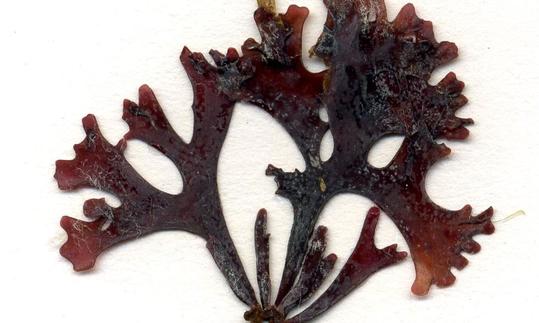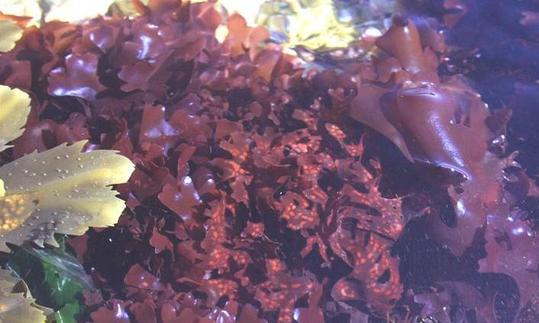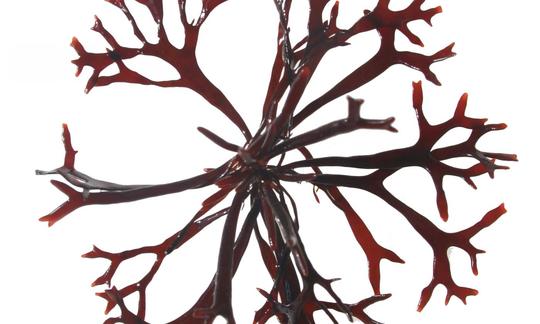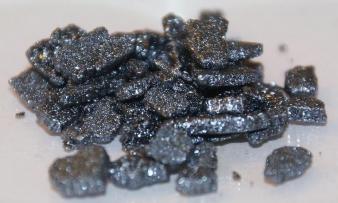Table of contents
Irish moss ( Chondrus crispus ) is a red algae that is primarily used as a vegan gelling agent. However, it can also be enjoyed raw in salads or cooked in soups and stews (preferably in organic quality).
Use in the kitchen
Carrageenan, also known as Irish moss, is a red algae seaweed that is widespread in the North Atlantic. It is harvested primarily as a raw material for the production of carrageenan (polysaccharide), which is used in the food and cosmetics industries as a thickener, stabilizer and emulsifier. 1
However, the dried seaweed is also sold for private use, where it is also used as a vegan gelling agent in most cases. To do this, dried cartilage kelp is soaked in water overnight and the swollen seaweed is processed into a gel-like paste (see chapter "Recipe for Irish moss paste"). The plant-based gelatin alternative has hardly any taste of its own and is therefore suitable for making jams, puddings, creams and other desserts. When baking, cartilage kelp gel serves as a vegan egg substitute. Cartilage kelp is perfect for thickening soups, sauces and stews.
Irish moss can also be used raw in the kitchen and not made into a paste. The dried seaweed also needs to be soaked in water for a short time (about an hour) before it can be prepared. The crunchy red algae tastes best raw as an ingredient in salads with lettuce and vegetables (e.g. with red onions and radishes ) or in a pasta salad (e.g. with cherry tomatoes and avocado ). The algae can also be used to make delicious smoothies, for example with plant-based milk, kiwi, zucchini, mango and hemp seeds . Along with plant-based milk,vanilla, cinnamon and nutmeg, seaweed is the main ingredient in a traditional Jamaican drink, the "Irish Moss Drink".
You can also cook with the seaweed fresh or soaked in water. It goes particularly well in soups or stews, such as a simple stew with potatoes, onions and, if you like, nori . You can also make a healthy tea with Irish moss (see the chapter "Tea preparation").
Vegan recipe for cartilage seaweed and cucumber salad
Ingredients (for 2 people): 6-8 g cartilage seaweed (dried, preferably organic), 2 cucumbers, 1 spring onion, ½ chili pepper, 2 tbsp sesame seeds, 3 tbsp soy sauce, 2 tbsp hemp oil, 1 tsp sesame oil, 1 tsp agave syrup, 1 tbsp lemon juice, 1 tsp lemon peel (zest of an organic lemon ), ½ tsp garlic powder, 1 pinch of ginger powder, a littlepepper .
Preparation: Cover the dried seaweed with water in a bowl and leave to soak for an hour. For the dressing, put the soy sauce, hemp oil, sesame oil, agave syrup, lemon juice, lemon zest, garlic powder and ginger powder in a bowl and mix everything together well. After the soaking time of the cartilage seaweed has elapsed, drain the seaweed, rinse with cold water, drain and pat dry with a cloth. Remove any overly hard parts with a knife and cut the rest into bite-sized pieces. Place in a bowl, pour the dressing over it and leave to soak for about 30 minutes. Meanwhile, cut the cucumber into cubes and the spring onions into fine rings. Deseed the chili pepper and chop finely. Add the cucumber cubes, spring onion rings and chili to the seaweed and the dressing and mix well. Season with a little pepper if necessary, sprinkle the vegan seaweed and cucumber salad with sesame seeds and serve.
Vegan recipe for Irish moss paste
Ingredients (approx. 10 servings): ½ cup kelp (dried, organic), 1-2 cups water .
Preparation: Place dried red algae in a bowl full of water and wash thoroughly until there is no visible dirt left. Pour off dirty water and rinse off algae. Repeat the washing process if necessary. Place algae in a clean, large bowl and cover with enough water to cover all parts of the cartilage seaweed. Leave to swell at room temperature for 12-24 hours. Place the swollen cartilage seaweed in a blender and puree with a cup of water until the mixture is smooth. If necessary, add a second cup of water (but no more). Pour the vegan moss paste into a mason jar and place in the refrigerator. After about 2 hours, the gel-like paste should have thickened. It will keep for up to a month in the refrigerator and up to three months in the freezer.
Tea preparation
ingredients (1 cup): 1 teaspoon (approx. 1.3 g) Irish moss (dried, preferably organic), 150 ml boiling water.
Preparation: Pour boiling water over the cartilage kelp and let it steep for 10-15 minutes. Then strain and enjoy. If you like, you can sweeten the tea with a little agave syrup or season it with a little lemon juice, cinnamon or nutmeg. The tea is also recommended brewed with tea herbs or ginger .
Vegan kelp recipes (raw) can be found under the note: " Recipes that have the most of this ingredient ".
| Not only vegans or vegetarians should read this: Vegans often eat unhealthily. Avoidable nutritional mistakes . |
Purchasing - Storage
Where can you buy kelp? Major retailers such as Coop, Migros, Denner, Volg, Spar, Aldi, Lidl, Rewe, Edeka, Hofer, Billa etc. and organic supermarkets such as Denn's Biomarkt and Alnatura usually do not offer kelp. The harvest season is in summer . Kelp is available online all year round as dried algae, whole or processed into flakes or powder. Whether the Irish moss available is of raw food quality depends largely on the drying process and processing used. However, gently dried, raw Irish moss can be found on the Internet. Kelp capsules are also available to buy as a dietary supplement.
Fresh seaweed can occasionally be bought online in salt water (sea water) or preserved in salt. Seaweed salad (with various types of seaweed), refined with vinegar, oil, soy sauce, etc., can also be found on the Internet.
The availability of cartilage kelp varies depending on the size of the store, catchment area, etc. Our recorded food prices for the DA-CH countries can be found above under the ingredient image - and by clicking on them you can see their development at various suppliers.
Storage tips
Dried cartilage kelp will last up to a year if stored in a dry, cool and dark place and in an airtight container. Fresh or soaked seaweed should be stored in the refrigerator and consumed within three weeks. Rinse the seaweed sporadically with water.
Ingredients - Nutritional values - Calories
The energy content of sea moss (raw) is 49 kcal and is therefore low. With 0.16 g/100g of fat, the seaweed is also low in fat. It contains 12 g/100g of carbohydrates and 1.5 g/100g of proteins. The salt content of 170 mg/100g covers 7.1% of the daily requirement. This content is usually higher in dried seaweed, e.g. in dried dulse (366 mg/100g). Dried kombu seaweed contains unhealthy amounts of salt, with 7112 mg of table salt per 100g. 2 The following are three important nutrients, which are present in considerable quantities.
There are 6100 µg of iodine in 100 g of raw Irish moss. Raw wakame has a slightly lower value of 4200 µg/100g. Raw laminaria algae contains a lot of iodine (38,000 µg/100g). 2
Raw kelp is rich in folate (ex vitamin B9, B11 ) . The content of 182 µg/100g (91% of the daily requirement) is similar to that of bladderwrack (180 µg/100g), laminaria (kelp; 180 µg/100g) and arame seaweed (180 µg/100g). Raw wakame has a little more at 196 µg/100g and dried dulse (ragweed) has about seven times as much vitamin at 1269 µg/100g. 2
The trace element iron is also present in a significant amount at around 8.9 mg/100g (64% of the daily requirement). Lemongrass (8.2 mg/100g) contains a similar amount. Spirulina contains even more iron (28 mg/100g), but only small doses of the powder are used. 2
The complete ingredients of cartilage kelp (raw), the coverage of the daily requirement and comparison values with other ingredients can be found in our nutrient tables. In the article Nutrients explained you will get a detailed insight into the topic.
Health effects
Is carrageenan healthy? Carrageenan is a sulfated polysaccharide found in carrageenan. In addition to its use in the food and pharmaceutical industries as a natural gelling agent, thickener, binder, stabilizer and additive, the polysaccharide is believed to have health benefits. There are a growing number of scientific studies indicating that carrageenan has anti-cancer properties. 4,5 Furthermore, the results of some studies ( in vitro and in vivo ) showed that the polysaccharide, when combined with conventional drugs, not only produced more effective anti-cancer activity, but also improved immune competence damaged by drugs by increasing the weight of the spleen, reactivating the spleen, activating lymphocyte proliferation and restoring TNF-α levels. 5
In addition, cartilage kelp contains phycobiliprotein, a group of membrane-associated photosynthetic pigments that only occur in red algae, cyanobacteria and cryptophyceae. These are used commercially as anti-inflammatory agents. They also have antidiabetic and antioxidant effects. 3
Secondary plant substances
Many of the health effects of cartilage kelp can be attributed to the secondary plant substances it contains. Our article on secondary plant substances provides an overview of the classification of substance groups, their occurrence in foods and possible effects on humans. Cartilage kelp contains the following secondary plant substances, among others: 3,16,21
- Isoprenoids: Tetraterpenes: Carotenoids (carotenes: beta-carotene; xanthophylls: lutein, fucoxanthin)
- Polyphenols: Phenolic acids: hydroxybenzoic acid (gallic acid, protocatechuic acid, genistic acid, p-hydroxybenzoic acid), hydroxycinnamic acids (p-coumaric acid, cinnamic acid); Flavonoids: flavanols (catechin), Isoflavones (Daidzin, Daidzein, Genistein, Genistin, Ononin, Sissotrin, Formononetin, Biochanin A); Tannins
- Other organic compounds: carboxylic acids (uronic acid, oxalic acid, shikimic acid, citric acid)
- Protease inhibitors: Chlorophyll A, Chlorophyll A derivatives
However, it should be noted that the composition of secondary plant substances in cartilage kelp can vary depending on the variety, time of harvest and growing conditions. Therefore, quantities are only of limited use and should only be understood roughly.
Studies documented the presence of flavonoids (202.66 µg/mg) as the main fraction from the methanolic extract of C. crispus, followed by tannins (13.64 µg/mg) and phenols (12.38 µg/mg). Among the phenolic components, catechin (2.335 µg/ml), p-coumaric acid (0.581 µg/ml) and gallic acid (1.09 µg/ml) were the main constituents, while protocatechuic acid (0.199 µg/ml), gentisic acid (0.186 µg/ml), p-hydroxybenzoic acid (0.255 µg/ml) and cinnamic acid (0.050 µg/ml) were present in lower concentrations. Various studies demonstrate the antioxidant, antibacterial potential and effectiveness against various Candida microorganisms of cartilage kelp. 16,21 The phenolic components of cartilage kelp extract have an antidiabetic effect. 3
A 2015 study investigated the effects of kelp on the nematode Caenorhabditis elegans, a typical model organism in biology. The results of the study suggest that a methanolic extract of kelp has neuroprotective activity. This protective effect could be attributed to the reduction of oxidative stress and the upregulation of stress response genes. The different components of the extract may act synergistically to protect nerves. Kelp is considered promising for potential anti-neurodegenerative drugs for humans. 1
Dangers - Intolerances - Side effects
Algae contain the essential trace element iodine, which plays an important role in thyroid function. It is required for the synthesis of thyroid hormones. However, long-term, excessive intake of iodine can lead to thyroid dysfunction such as hyperthyroidism or hypothyroidism. A 2020 study determined the iodine content of 30 red algae samples, more specifically dulse species and cartilage kelp species, in order to assess the iodine exposure from their consumption. The results showed that dulse algae has a higher iodine content than cartilage kelp algae, but that neither poses a health risk if the recommended daily consumption of seaweed (4 g/day) is observed. 6 When purchasing algae products, however, make sure that the iodine content and a maximum recommended daily consumption amount are stated. This way you can estimate how much iodine you are consuming and avoid excessive intake.
A 2015 study determined the levels of toxic elements (such as aluminum, silicon, arsenic, cadmium and lead) in 14 edible seaweed species (including Chondrus crispus ). Although the samples were not free of contaminants, the concentrations were below levels that are hazardous to health. Nevertheless, continuous monitoring of contaminants in edible and commercialized seaweed is important. 7
The polysaccharide carrageenan, which is extracted from cartilage kelp, is used as an additive (E407) in some foods. The body does not absorb it and excretes it unchanged, but carrageenan could reduce the absorption of other food ingredients. The substance is also suspected of causing allergic reactions in sensitive people. In animal experiments, carrageenan affected immune system cells. Studies confirming this negative effect for humans are still lacking. The Scientific Committee on Food of the European Commission ( SCF ) also recommended that E407 should not be approved for infant formula, as it is not yet clear whether the intestines of infants can absorb carrageenan. 8
Folk medicine - natural medicine
Irish moss was a popular folk remedy for colds, coughs, sore throats, chest and lung diseases (including tuberculosis) in the coastal regions of Ireland. The algae were boiled in milk or water, the liquid strained and drunk hot. In County Leitrim (former county) in Ireland, the algae were also used for burns and in County Cavan for kidney problems. There are only a few records of the use of cartilage kelp in British folk medicine. On the Scottish island group, the Hebrides (South Uist), it was used as a poultice for stomach aches. On Skye (Scottish island), people rubbed it on tired feet. 9
Ecological footprint - animal welfare
Seaweed cultivation can produce large quantities of nutrient-rich food for human consumption. In addition, marine farms appear to be more sustainable than agriculture on land, as no fresh water (keyword: water footprint ), no chemical fertilizers and no (dry) land are needed to cultivate seaweed; these are major negative factors of agriculture. 10
Macroalgae absorb aqueous solutions containing carbon dioxide, nitrogen and phosphorus during their growth. They therefore show carbon sequestration during the cultivation phase, which results in a potentially negative carbon footprint of seaweed: -7.21 kg CO 2 eq/kg. 19 In order to be able to use this possibility of carbon fixation to mitigate climate change, concrete plans for implementation are still needed. 17
Algae can produce 167 times the amount of biomass per year compared to corn, and on the same area. In addition, algae do not need cellulose as a supporting material like most other plants - so the nutrient density is comparatively high. This efficiency in the cultivation of algae makes these organisms a very interesting food in terms of resource-saving agriculture. But of course, as always, it all depends on the implementation. 18 The use of seaweed as a resource-saving food on a large scale is only possible as long as the sea offers the necessary ecological conditions, in particular the right temperature. 20
For detailed explanations of various sustainability indicators (such as ecological footprint, CO2 footprint, water footprint), see our article: What does the ecological footprint mean?
Worldwide distribution - cultivation
Cartilaginous seaweed is found in the North Atlantic and is particularly widespread on rocky British and Irish coasts. It is also found in Iceland, the Faroe Islands, the western Baltic Sea, from northern Russia to southern Spain, the Mediterranean, Portugal, the Azores and West Africa. In North America it is found in Alaska and from Labrador in Canada to New Jersey in the USA. Cartilaginous seaweed is also found in the Bering Sea. 11
It is harvested primarily in Canada (Nova Scotia, Prince Edward Island), the United States (Maine, Massachusetts), France, Spain and Portugal to produce carrageenan. 11,12
Most of the biomass of cartilaginous kelp is obtained by harvesting wild algae. In Southeast Asia, attempts are being made to produce the red macroalgae in aquaculture facilities. There are hardly any such efforts on the western market. 13
Found in the wild,
kelp grows mainly along North Atlantic coasts, from the littoral zone to 20 m below mean low tide, depending on wave action, transparency and existing rock structures. In general, the red alga is most commonly found from mean low tide to the mid-sublittoral. It grows best on stable rocky outcrops and large boulders and prefers horizontal shelves. The breeding season begins in autumn and lasts until spring. The strongest growth takes place in late spring and summer, and the slowest growth in winter. 12 Therefore, kelp is harvested in the summer months ( season ).
Both Chondrus crispus and Mastocarpus stellatus are widespread in the British Isles and often grow side by side. Because they look almost identical, they are easy to confuse. Collectors often do not distinguish between the two and harvest them together. The two can be distinguished by the rounded stem, tubular leaves and warty reproductive body of the starweed. 9,11
Another way to confuse Irish moss is with Icelandic moss, not visually, but in name. Icelandic moss ( Cetraria islandica ) is a lichen that occurs in temperate, cool to arctic regions of the entire northern hemisphere. It is known primarily as an ingredient in lozenges, cough teas and other cold remedies. 14
Cultivation - Harvesting
Originally, Irish moss was harvested from storm-tossed seaweed that was blown ashore by strong winds. Local farmers collected the seaweed from beaches and shores. Later, fishermen took their boats and hand rakes out to sea and scraped the seaweed from flat rocks. In the 1970s, large lobster boats with drag rakes and winches were introduced. The use of these boats resulted in larger harvests, but had a negative effect on the regrowth of the seaweed. 12
The demand for Irish moss dropped sharply in the 1980s. This was because the algae Kappaphycus alvarezii and Eucheuma denticulatum, which are also used to produce carrageenan, could now be cultivated. Cultivation was more efficient and less expensive than collecting wild carrageenan. 12,15
Given the low demand from carrageenan processors, Irish moss harvesting has once again become a part-time fishery, with room for operators equipped with small boats, outboard motors and hand rakes. 12
After harvesting, a drying process usually follows to make the algae last longer and easier to handle for retail. Hot air drying is the most widely used drying method in the food industry. Other convective drying preservation techniques are freeze drying, heat pump drying, spray drying and hot steam drying. Conductive and radiative drying methods are also possible methods for preserving the algae. 16 Drying can also take place gently in the sun, so that the dried algae have raw food quality.
Further information
The Irish moss ( Chondrus crispus ) is a macroalgae that belongs to the phylum of red algae (Rhodophyta) and the family Gigartinaceae. It is characterized by its cartilaginous and branched shape and reaches a height of 12 to 22 cm. When fresh, the Irish moss is violet to red, but can also appear greenish in strong sunlight. 11 When dried, it has a yellowish color and a horn-like structure.
The name Irish moss is due on the one hand to the occurrence and long history of cartilage kelp in Ireland and on the other hand to the moss-like growth form of the algae on rocks.
Alternative names:
Carrageenan has several alternative names such as Irish moss, Irish moss, (Irish) pearl moss, carrageenan moss, carrageenan algae or carrageen moss. The English name for carrageenan (German) is Irish moss, sea moss or carrageen moss.
Other uses
The polysaccharide carrageenan, which is found in some red algae, is used as additive E407 in many foods. The additive acts as a gelling agent and is mostly used in mixtures with other vegetable thickeners. It is often found in pudding and dessert powders, ice cream, curdled milk products, heat-treated cream, sweets, ketchup and sauces. 8
Bibliography - 21 Sources
| 1. | Liu J, Banskota AH et al. Neuroprotective Effects of the Cultivated Chondrus crispus in a C. elegans Model of Parkinson’s Disease. Mar Drugs. 2015;13(4):2250–2266. |
| 2. | USDA United States Department of Agriculture. |
| 3. | Ismail MM, Alotaibi BS, El-Sheekh MM. Therapeutic Uses of Red Macroalgae. Molecules. 2020;25(19):4411. |
| 4. | Khotimchenko M, Tiasto V et al. Antitumor Potential of Carrageenans from Marine Red Algae. Carbohydr Polym. 2020;246:116568. |
| 5. | Liu Z, Gao T et al. Anti-Cancer Activity of Porphyran and Carrageenan from Red Seaweeds. Molecules. 2019;24(23):4286. |
| 6. | Darias-Rosales J, Rubio C et al. Risk Assessment of Iodine Intake from the Consumption of Red Seaweeds (Palmaria palmata and Chondrus crispus). Environ Sci Pollut Res Int. 2020;27(36):45737–45741. |
| 7. | Desideri D, Cantaluppi C et al. Essential and Toxic Elements in Seaweeds for Human Consumption. Journal of Toxicology and Environmental Health, Part A. 2016;79(3):112–122. |
| 8. | Zusatzstoffe Online de E 407 Carrageen. |
| 9. | Allen DE & Hatfield G. Medicinal Plants in Folk Tradition. An Ethnobotany of Britain and Ireland. Timber Press: Portland; 2004: 44. |
| 10. | Tiwari BK, Troy DJ. Seaweed Sustainability – Food and Nonfood Applications. Seaweed Sustainability. Academic Press. 2015;1–6. |
| 11. | Marlin ac uk Carrageen (Chondrus crispus). |
| 12. | Fao org Seaweeds used as a source of Carrageenan. |
| 13. | Tanoeiro JR, Fortunato D et al. Different Chondrus crispus Aquaculture Methods and Carrageenan Extraction. Applied Sciences. 2023;13(9):5466. |
| 14. | Naturschutzbund Deutschland. Hustenmittel und Leibspeise der Rentiere. Das Isländische Moos im Porträt. |
| 15. | Zertuche-González JA, García-Lepe G et al. Open Water Chondrus crispus Stackhouse Cultivation. Journal of Applied Phycology. 2001;13(3):247–251. |
| 16. | López-Hortas L, Caleja C et al. Comparative Evaluation of Physicochemical Profile and Bioactive Properties of Red Edible Seaweed Chondrus crispus subjected to Different Drying Methods. Food Chemistry. 2022;383:132450. |
| 17. | Ross FWR, Boyd PW et al. Potential role of seaweeds in climate change mitigation. Science of The Total Environment. 2023;885:163699. |
| 18. | Diaz CJ, Douglas KJ et al. Developing algae as a sustainable food source. Front Nutr. 2023;9:1029841. |
| 19. | Zhang R, Wang Q et al. Environmental benefits of macroalgae products: A case study of agar based on life cycle assessment. Algal Research. 2024;78:103384. |
| 20. | Bartsch I, Wiencke C, Laepple T. Global seaweed biogeography under a changing climate: the prospected effects of temperature. In: Wiencke C, Bischof K, Herausgeber. Seaweed Biology: Novel Insights into Ecophysiology, Ecology and Utilization [Internet]. Berlin, Heidelberg: Springer; 2012. S. 383–406. |
| 21. | Park SJ, Sharma A, Lee HJ. An update on the chemical constituents and biological properties of selected species of an underpinned genus of red algae: chondrus. Marine Drugs. Januar 2024;22(1):47. |












Comments